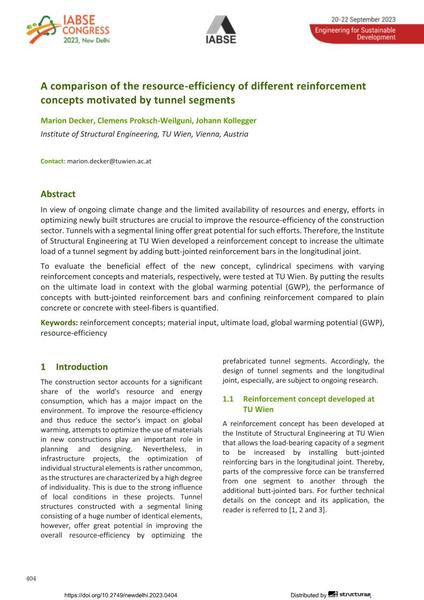A comparison of the resource-efficiency of different reinforcement concepts motivated by tunnel segments

|
|
|||||||||||
Bibliographic Details
| Author(s): |
Marion Decker
(Institute of Structural Engineering, TU Wien, Vienna, Austria)
Clemens Proksch-Weilguni (Institute of Structural Engineering, TU Wien, Vienna, Austria) Johann Kollegger (Institute of Structural Engineering, TU Wien, Vienna, Austria) |
||||
|---|---|---|---|---|---|
| Medium: | conference paper | ||||
| Language(s): | English | ||||
| Conference: | IABSE Congress: Engineering for Sustainable Development, New Delhi, India, 20-22 September 2023 | ||||
| Published in: | IABSE Congress New Delhi 2023 | ||||
|
|||||
| Page(s): | 404-410 | ||||
| Total no. of pages: | 7 | ||||
| DOI: | 10.2749/newdelhi.2023.0404 | ||||
| Abstract: |
In view of ongoing climate change and the limited availability of resources and energy, efforts in optimizing newly built structures are crucial to improve the resource-efficiency of the construction sector. Tunnels with a segmental lining offer great potential for such efforts. Therefore, the Institute of Structural Engineering at TU Wien developed a reinforcement concept to increase the ultimate load of a tunnel segment by adding butt-jointed reinforcement bars in the longitudinal joint. To evaluate the beneficial effect of the new concept, cylindrical specimens with varying reinforcement concepts and materials, respectively, were tested at TU Wien. By putting the results on the ultimate load in context with the global warming potential (GWP), the performance of concepts with butt-jointed reinforcement bars and confining reinforcement compared to plain concrete or concrete with steel-fibers is quantified. |
||||
| Keywords: |
global warming potential (GWP) ultimate load reinforcement concepts material input resource-efficiency
|
||||
